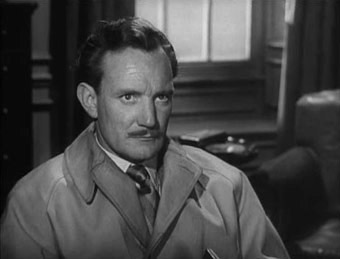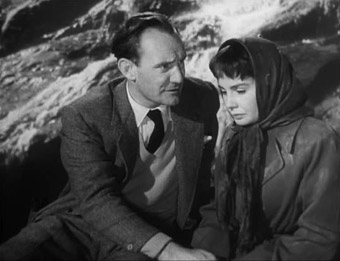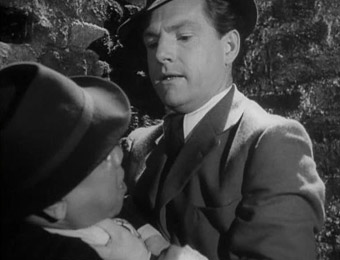|
It's recently been announced that London and Birmingham are to become the beneficiaries of a new high speed rail service, linking the two cities and cutting the standard journey time almost in half. There are plans to further the network in the years that follow to include Leeds, Sheffield and Manchester, a move that would cut the journey south to north down to a staggeringly commutable 75 minutes. Doubtlessly this will be a great boon to Britain's economy, make the working population more mobile than ever and connect the capital to the provinces in a way unimaginable up till now. It will also mean that a film like The Clouded Yellow will be seen by future generations (whizzing up and down the country at 440mph) as a relic, a landscape that will seem unrecognisably bewildering. Britain is no longer a place you can escape into. You can't go on the run here anymore.
Not that this was a problem back in 1951 of course. Here, Trevor Howard plays David Sommers, a British agent who returns to home after a mission to secure a defection goes awry. He is ejected from the service (in a cracking early scene featuring the great Andre Morell as his spy chief) and is advised to find a quiet job somewhere the service can keep an eye on him. He winds up cataloguing butterflies for the Fenton family; Nicolas (Barry Jones), his wife Jess (Sonia Dresdel) and troubled niece Sophie (Jean Simmons). Sophie's mental state is something of a taboo for the family, made worse by the overbearing Jess keeping her as a virtual prisoner in the house, but alleviated somewhat by the rapport David manages to strike up with Sophie during his tenure at the house. When Sophie is accused of murdering a local heavy, David comes to her aid, helping her escape out of the house and using his talent for smuggling people to keep her out of reach of the law whilst they try to work out who the real killer is. A former colleague of David's, Willy (Kenneth More) is dispatched by the service to track them down and prevent a national scandal.

There's actually a good portion of time before the star couple go on the run, so much so that the film at first engages the viewer as a gothic psychological horror. A worldly man enters an uncanny, rural domestic space and becomes entangled in the family melodrama featuring taxidermy, an evil-looking aunt and a house-trapped, psychologically disturbed young woman. This first act is expertly handled, with good performances across the board and some very offbeat characters. David himself is not all he seems, as he keeps his secret service past hidden from the family. Why does Nicolas collect butterflies? Why is Sophie so unhinged; why is Jess so controlling of her and why does she hate it when Sophie plays the piano? The standout role early on is Hick, a sleepy-eyed, bequiffed rustic poacher who bullies Sophie, blackmails Jess and winds up the victim of a knife in the back. The house itself is incredibly eerie, being a mixture of Stuart-era country manor, baroque mansion and breezy suburban modernity. The film image drinks in light from all of the constantly open windows, glass patio doors, fluttering net curtains – rather than being introvert and oppressive, the setting is opened up to the outside world, spaces are connected to each other and before long the feeling emerges that the house is very insecure. Danger could stroll in from any part of the frame, and it is significant that the pivotal murder occurs in the house's garden.
The first act is creepy and uniquely atmospheric, but it doesn't outstay its welcome. The plotting of The Clouded Yellow is superb. The economy of story is airtight, not a moment of screen time is wasted, and the pace of the narrative is perfect. The transition from psychological thriller to fugitive storyis done with such delicacy as to be barely noticeable: Sommers leaves Sophie in a café with instructions to meet him at Holborn station; he meets with his former boss and is advised to return to the Sophie with the police; he returns to the café with the police, points 'Sophie' out to them and then excuses himself; Sommers meets Sophie at Holborn. The whole sequence is played deliberately relaxed, with no music or extravagant editing, none of the visual handholding that characterizes many a good thriller. It's an incredibly fluid move that reflects the casual, unfussy competence of the story's protagonist (the way he excuses himself from the café to escape the police is marble smooth) and is a tribute to the brisk efficiency of screenwriter Janet Green's work.
The couple-on-the-run portion of the film takes up most of the second and third act, and zips along at pace. It's fascinating to see a portrayal of Britain as a place where the law can be evaded, where people can hide out and where escape is possible internally. Interestingly, in the absence of truly vast spaces, the pursuit is mainly articulated through changing transport: bus, bicycle, running, rowing boat, stolen car and ambulance are all employed at some point in the film. Likewise the lack of expanse is compensated for by the variation presented in the locations that are chosen. The couple are propelled to Newcastle, the Lake District, the Pennines and Liverpool, pursued at every turn by the entirety of the Greater Yorkshire constabulary: indeed, the takes of Sommers and Sophie fleeing over the craggy moors and brooks of North Yorkshire as Keystone coppers fan out in futile pursuit are strongly reminiscent of The 39 Steps. Fans of The Fugitive will also get a kick out of the Kenneth More role, as a reluctant hunter on the trail of our heroes.

Along the way we start to see an interesting hint of the modern Britain that is emerging from the shabby post-war rubble: a maid uses a hoover in the Hertfordshire manor house; Sommers deals with Chinese spivs in an effort to get false papers; Brutalist architecture towers in the background of the cities and ethnic groups are shown mingling amongst the Liverpool dockers. Again, you get the feeling that this new world of multiculturalism, tourism and international commerce (Sommers is a globe-trotting dealer in people, after all) means that domestic thriller stories like this will at the very least have to change, if not vanish altogether. Not in a reactionary way, but in a way that celebrates the form that is being transmuted. By the time we get to the end of the film the narrative changes gears again to become something like a slasher film – another transition that is presented smoothly and coolly. All of this action is rendered through the exquisite photography from the legendary Geoffrey Unsworth (2001, A Bridge Too Far) that captures the guidebook finery of the Lakes as tangibly as it does the overcrowded, dusty-hot slums of Liverpool and oily, smoke-stained Newcastle. There is also some very nice noir-ish lighting that isn't too insistent but gives a nice texture to some of the indoor scenes.
All in all The Clouded Yellow is a very efficient, neat and intriguing thriller that plays with its own genre and embraces several others. Tiny bits of business – Sommers lighter finally sparking to life once he goes on the run, the inclusion of a strange Geordie taxidermist who smuggles people out of the country, the use of a Chinese restaurant as a cover for criminal activity – add strands of colour to an already vivid tapestry. The acting and photography is sublime, the characters are well-drawn but this is ultimately about narrative: full of twists and turns, taking in the varied landscapes of Britain and showing a homegrown cinematic space we'll never see again. They won't make 'em like this anymore.
This is the second DVD release of A Clouded Yellow by Eureka in less than two years, with this second version designed in part to right a notable wrong of the first, which contained an incomplete cut of the film. The version on this new disc is the uncut print, which contains approximately ten minutes of extra footage that is distributed throughout the running time. What follows is a breakdown of the material restored for this version.

-
A new opening scene has David arriving at an unspecified British airport at night, greeting a customs officer by his first name and admitting that he has no passport and being let through to see the airport security officer.
-
The scene where David reports to his boss starts earlier and a conversation between them reveals that he was injured on this latest job and further suggests he may be past his service prime.
-
The scene is also extended in its second half, with David told he will receive a decoration, "for the times you didn't miss."
-
Instead of fading out when David leaves the office, the scene continues as his boss makes a call to tell Willy that David has just left.
-
A scene follows in which Willy meets David in a bar and the two chat briefly about their (fake) careers – David is apparently a newspaperman, Willy cheerfully unemployed.
-
The employment agency scene with Richard Wattis starts earlier and establishes that, apart from his skill with languages and experience as a newspaperman, David has no formal qualifications and that he'd rather be known as Mr. Sommers than Major Sommers.
-
Following David's departure to the garden after his first conversation with Sophie, there's a new scene in which Fenton outlines the basics of his cataloguing system to David, followed by a fade-out and shot of David at work later and lot in thought, which is disrupted by the sound of an arriving lorry.
-
After Jess tells Sophie she shouldn't take advantage of David, a new scene has been inserted in which Sommers delivers an envelope to Jess given to him by Hick, ostensibly an invoice but clearly a letter, one Jess reacts to coldly and slowly tears up.
-
Immediately following this is a key sequence in which David is unable to sleep and Sophie, after a restless slumber, wakes, secretly leaves the house and heads across the gardens outside, observed by Jess from her room. This gives the suggestion that she may have been responsible for the murder a lot more weight.
-
After David's boss offers to lend the police superintendent one of their men, there's a new scene of David and Sophie listening to news of the police search for them on the radio.
-
An additional short scene has been reinstated of Sophie hiding from the police as she makes her way through the docks and pursued by the killer.
-
The warehouse chase runs for twice as long and the tension is increased as a result.
-
Sophie reaches the warehouse roof a realises she may be trapped. The police drive up below.
-
There are more shots of the police and Sophie on the roof, and David calls out for the crane to be lowered. The killer reaches the roof and Sophie climbs up to the top.
There is a small glitch in the restoration for those of you who like spotting that sort of thing, though I can't confirm whether it's made its way to the release disc. Following the reinstated scene of David and Sophie on the boat, there's a single frame of the preceding scene, the result of an edit made just a frame too early. Unless you're searching for it you probably won't see it clearly, but you may well get a subliminal sense of what is essentially a flash frame.
This version appears to have been created from two different sources. The Janus Films print from the previous release has been used for the bulk of the transfer, and the quality is similarly impressive (you can check out our review of the original release here). The reinstated scenes and the surrounding footage have been sourced from a slightly lower quality original and display a weaker contrast range, but the difference is not substantial enough to be distracting.
As with the previous release, the soundtrack is reasonably clear by shows its age in the dynamic range and the variable background hiss and fluff, though this is never a problem.
Unfortunately, no extra material is present.
This is a marvellous film, making up for the lack of bonus material. The cast, script and direction are on object lesson in filmmaking. Given the bloated, indulgent nature of some recent cinematic thrillers, The Clouded Yellow should be required viewing for anyone working in the genre.
|